Quick Takeaways
-
Microsoft revealed that Chinese threat actors began exploiting SharePoint zero-day vulnerabilities, dubbed ToolShell, as early as July 7, prior to their patching, with targeted high-value sectors including defense and government.
-
The vulnerabilities involved are CVE-2025-49706 (spoofing) and CVE-2025-49704 (remote code execution), reported in May and patched in July, but confusion exists about whether additional bypass vulnerabilities (CVE-2025-53770 and CVE-2025-53771) were also exploited.
-
Microsoft linked the attacks to Chinese state-sponsored groups, Linen Typhoon and Violet Typhoon, while a third group, Storm-2603, has also been observed engaging in these zero-day attacks.
- Over 9,000 SharePoint instances were exposed when the attacks were publicized, with hundreds actively targeted in the immediate aftermath, prompting urgent calls for organizations to apply patches rather than rely on mitigations like the Antimalware Scan Interface (AMSI).
Key Challenge
In recent developments reported by Microsoft, Chinese threat actors have been found to have exploited zero-day vulnerabilities in SharePoint systems weeks prior to their official patching. The vulnerabilities, collectively referenced as ToolShell—specifically CVE-2025-49706 and CVE-2025-49704—were first publicized following a series of attacks that began on July 18, although Microsoft indicates that attempts to exploit them might have begun as early as July 7. The tech giant ascribes these exploits to two state-sponsored groups, Linen Typhoon and Violet Typhoon, which have a history of targeting high-value sectors such as defense and human rights, as well as a third group, Storm-2603, signaling a broad campaign against unprepared SharePoint instances.
Despite Microsoft’s divulging of this alarming information, ambiguity persists regarding the exact nature of the vulnerabilities exploited. While cybersecurity firms have posited that attackers may have chained additional CVEs—CVE-2025-53770 and CVE-2025-53771—Microsoft has yet to confirm these claims in their advisories. As this disinformation circulates, cybersecurity experts urge organizations to prioritize patching over reliance on mitigations like the Antimalware Scan Interface (AMSI), highlighting that more than 9,000 SharePoint instances remained exposed at the time of the reports. This situation underscores the urgency of robust Cyber Defense mechanisms to thwart sophisticated, state-sponsored attacks.
Risk Summary
The exploitation of SharePoint zero-day vulnerabilities by Chinese threat actors poses a significant, multifaceted risk to businesses, users, and organizations, creating a domino effect that threatens not just immediate victims but the broader cybersecurity landscape. With high-value entities across varied sectors already targeted, the potential for data breach cascades becomes alarming; compromised credentials and stolen intellectual property can facilitate further attacks, undermining sensitive systems and eroding trust in digital infrastructures. As the methodologies of these state-sponsored groups become entrenched, businesses risk becoming collateral damage in a larger geopolitical cyber conflict, while users may find their personal data increasingly vulnerable to theft or misuse. Moreover, the ambiguity surrounding which specific vulnerabilities—such as CVE-2025-49706 or CVE-2025-49704—are actively exploited muddles the defensive posture organizations can adopt, leading to misguided trust in inadequate mitigations, such as AMSI, which in practice prove insufficient against sophisticated adversaries. Failing to enact timely patches not only endangers individual organizations but also galvanizes a climate of insecurity, enabling a pervasive ripple effect that can destabilize entire industries and compromise the collective integrity of digital systems globally.
Possible Actions
In the realm of cybersecurity, the swiftness of response is paramount, particularly when addressing vulnerabilities like the ToolShell zero-days exploited by Chinese APTs. The implications of such breaches can be profound, necessitating immediate and effective remedial actions.
Mitigation and Remediation Steps:
- Patch Management: Prioritize immediate application of the released patches for ToolShell vulnerabilities.
- Network Segmentation: Strengthen defenses by isolating critical systems to hinder lateral movement by attackers.
- Intrusion Detection Systems: Deploy enhanced monitoring tools to identify suspicious activities indicating exploitation attempts.
- User Education: Increase employee awareness of phishing and social engineering tactics that may exploit these vulnerabilities.
- Incident Response Plan: Activate and refine incident response procedures to quickly mitigate impacts from any possible breaches.
- Threat Intelligence: Stay updated with the latest threat intelligence feeds to recognize emerging tactics associated with APT groups.
NIST CSF Guidance:
The NIST Cybersecurity Framework emphasizes the necessity of identifying vulnerabilities and implementing rapid remediation strategies. For more detailed insights, organizations are encouraged to refer to NIST Special Publication 800-53, which provides comprehensive guidance for managing cybersecurity controls and risks effectively.
Advance Your Cyber Knowledge
Stay informed on the latest Threat Intelligence and Cyberattacks.
Explore engineering-led approaches to digital security at IEEE Cybersecurity.
Disclaimer: The information provided may not always be accurate or up to date. Please do your own research, as the cybersecurity landscape evolves rapidly. Intended for secondary references purposes only.
Cyberattacks-V1

